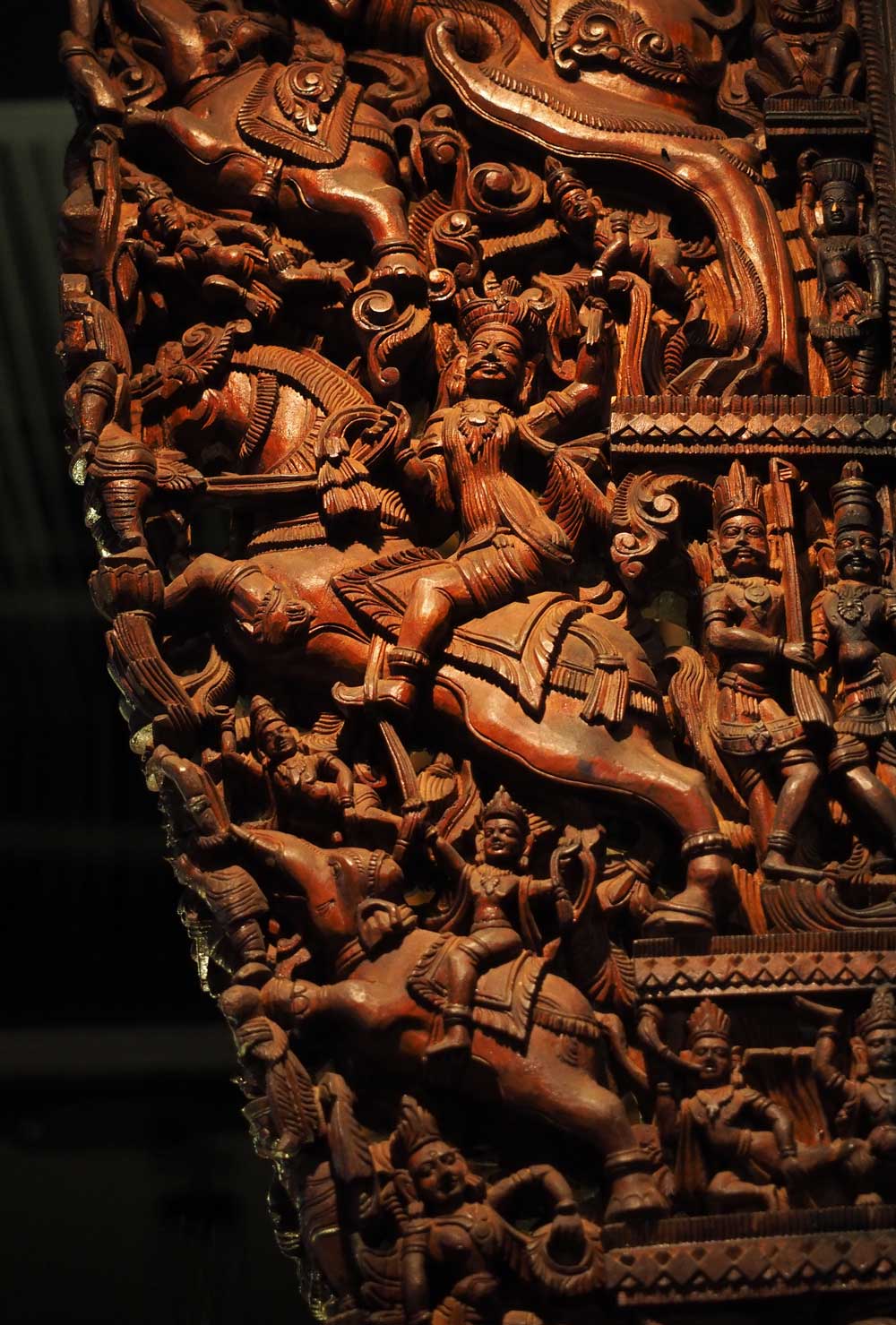
Chettinad doorway detail (late 19th C; mahua wood)
This incredibly intricate doorway, with its jambs and lintels, has about 5,000 minute carvings in a South Indian style.
18 February Singapore
On a mostly cloudy day I decided to stay in and try
to catch up a bit on photo sorting and working on this online journal. For a late
lunch I walked a bit over a kilometer northeast to a huge complex of food stalls—a
favorite dining style of Singaporeans—at Tiong Bahru Food Centre. The veggie stalls
had closed, but I found a little Indian place and got a decent plate of veggies,
dal, and rice.
19 February Singapore
I was hankering for top-notch
Indian cuisine, so got a double-decker bus to Little India, a region packed with
restaurants and shops just north of the center. Komala Vilas Vegetarian Restaurant
at 12-14 Buffalo Road looked straight out of India with plain décor and very good
food. I went for the South Indian thali, served on a banana leaf.
Next
I backtracked 1.2 kilometers on foot to one of the city’s great museums and its
oldest, the National Museum of Singapore https://www.nationalmuseum.sg/. I paid
the senior rate of S$19 for an All Access Pass that covered both the permanent and
special exhibitions. I especially liked the special exhibition downstairs, ‘An Old
New World’ that told about the age of exploration by the English and Dutch from
the 1600s up to the establishment of Singapore in 1819, and the peoples and nature
they encountered. The creative and well illustrated displays had early maps used
by the armed East Indiamen ship captains in search of valuable spices. Landscapes
and portraits showed native life through the eyes of European artists. Drawings
by naturalists detailed plants and wildlife new to the explorers.
Up
on Level 1 the large Singapore History Gallery charted changes from a crown colony
through the dark years Japanese of occupation, then post-war struggles and finally
today’s global city. On Level 2, ‘Life in Singapore: The Past 100 Years’ had four
galleries, of which I dropped into ‘Surviving Syonan’ about how civilians and prisoners
of war survived food shortages and torture under the Japanese; videos related eye-witness
accounts of the tragedies and triumphs. I ran out of time before seeing other three
galleries on Level 2. A bus brought me home.
20 February Singapore
On another partly cloudy day I returned to Little India by bus, then dropped into
the chain restaurant Ananda Bhavan (58 Serangoon Rd.) and had their North Indian
thali along with a milk tea. One block away at 5 Campbell Lane I visited the Indian
Heritage Centre https://www.indianheritage.org.sg/en with three floors of exhibits.
Displays on the 4th and 3rd floors of the contemporary building have many beautiful
artifacts and artwork that show early interactions between South and Southeast Asia,
stories about waves of migrations to Singapore, Indian pioneers, nationalist movements,
and prominent members of the Indian community here. The 2nd floor offered a special
exhibition about Singapore’s Tamil heritage, ‘From the Coromandel Coast to the Straits.’

Chettinad doorway detail (late 19th C; mahua wood)
This incredibly
intricate doorway, with its jambs and lintels, has about 5,000 minute carvings
in a South Indian style.
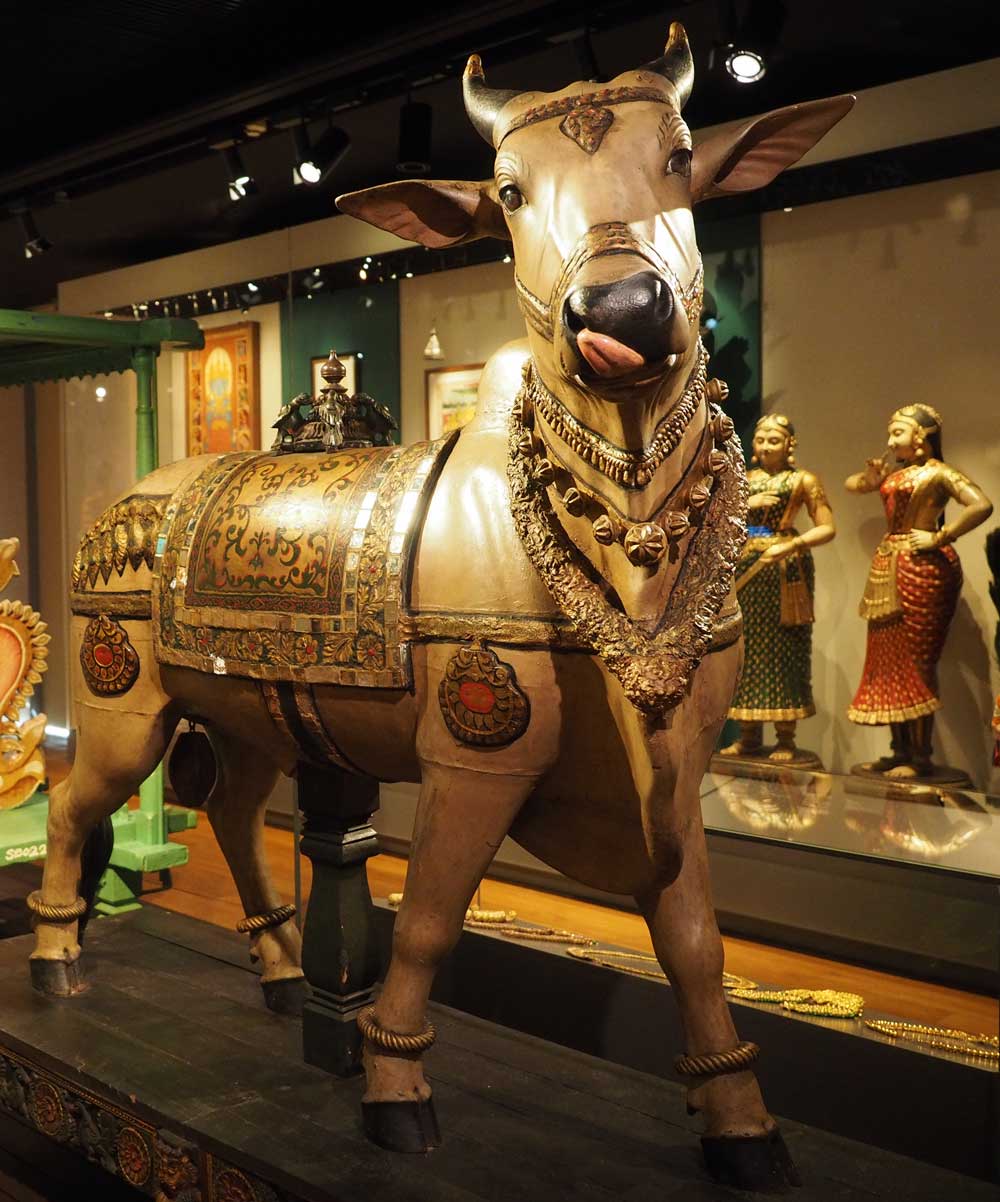
A Nandi processional vehicle (19th-20th C) of polychrome wood and
semi-precious stones from Tamil Nadu state.

Detail from Bengal Troops on the Line of March, A Panoramic sketch by
an Officer of that Army (19th C)
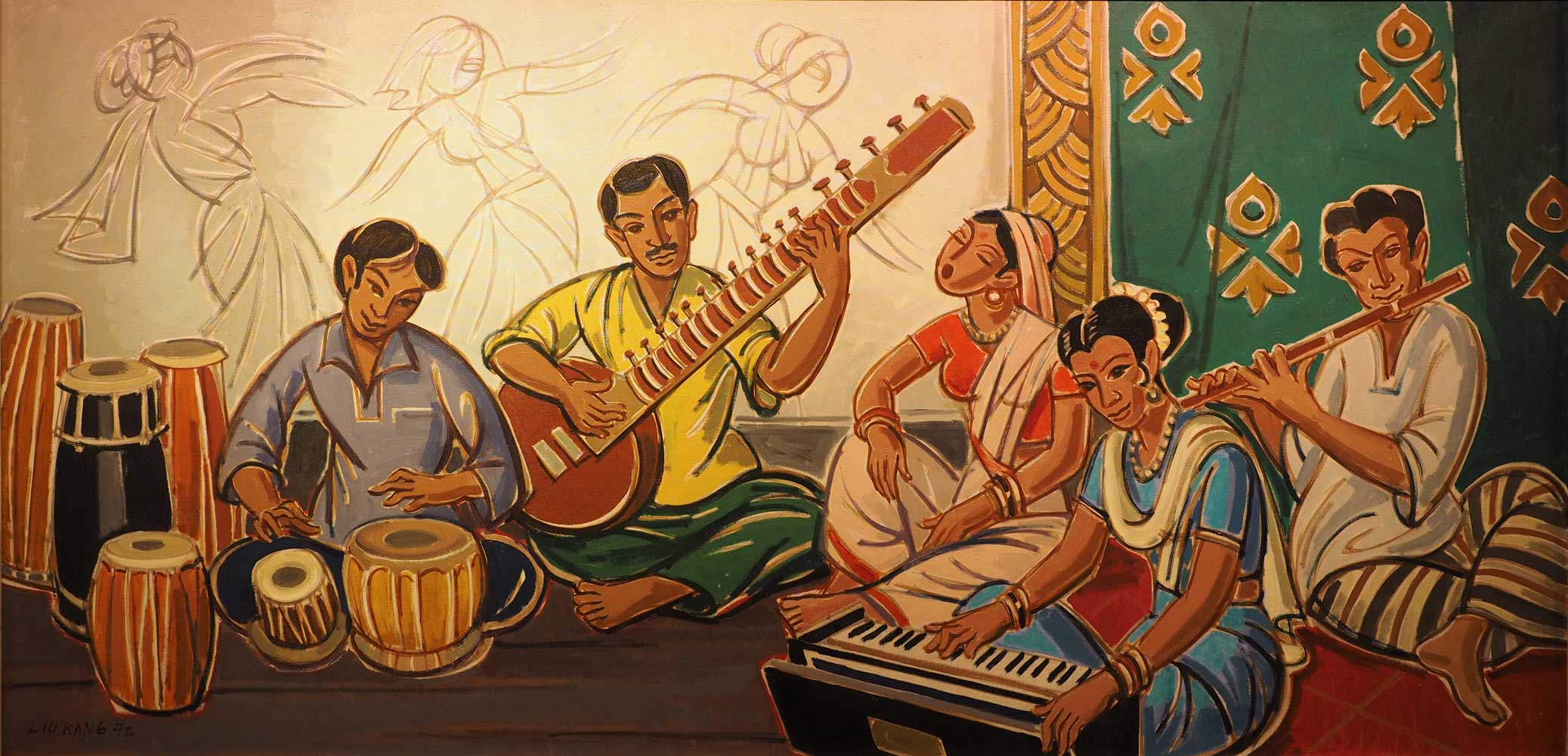
A Group of
Musicians (1972; Singapore) by Liu Kang
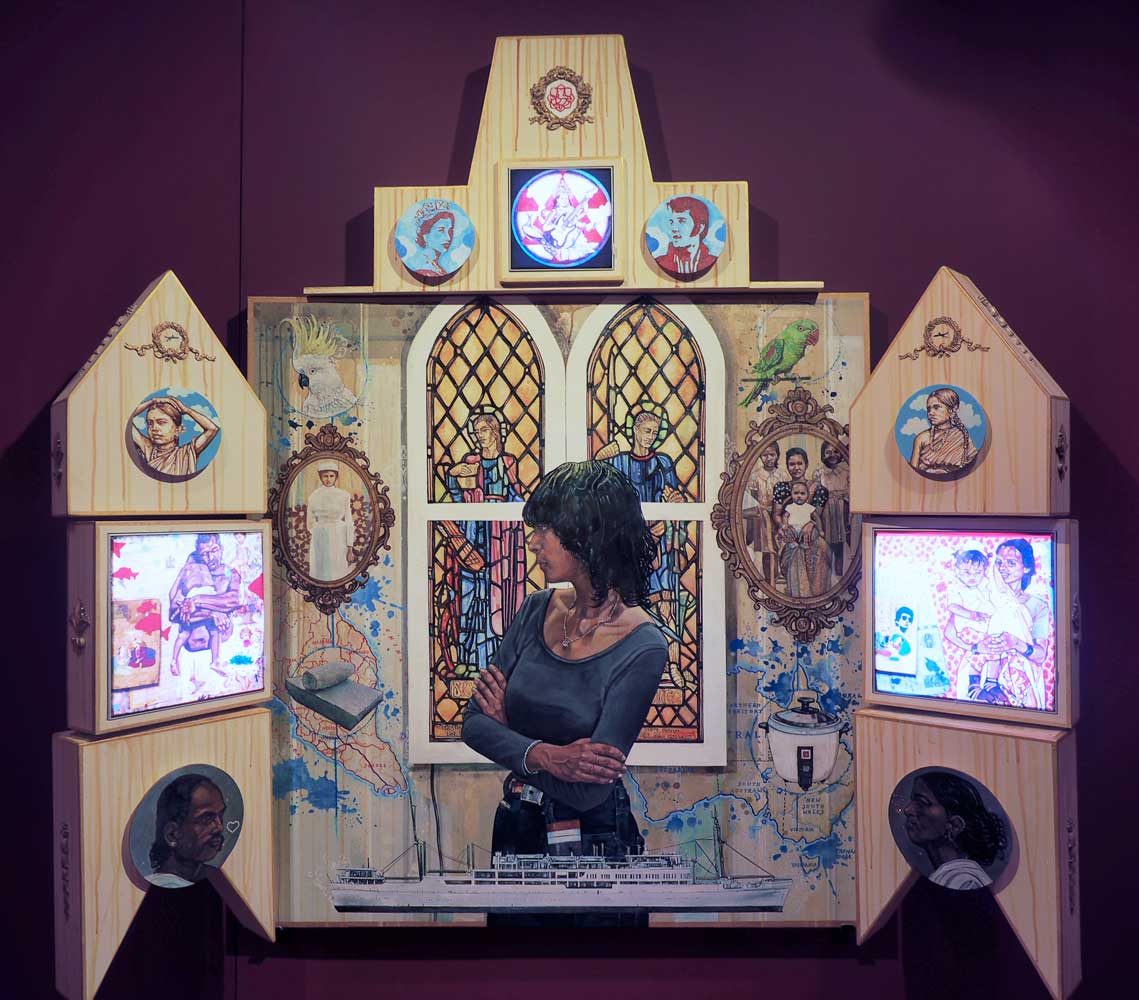
Heart in Hand: A Marriage of Identities (2019) by Anurendra Jegadeva and
commissioned by the Indian Heritage Centre. Little is known of the lives of
early Tamil migrants to Malaya and Singapore, so the artist attempts to recreate
the journey of a contemporary diasporic Tamil girl by using his daughter as the
central figure for this installation.
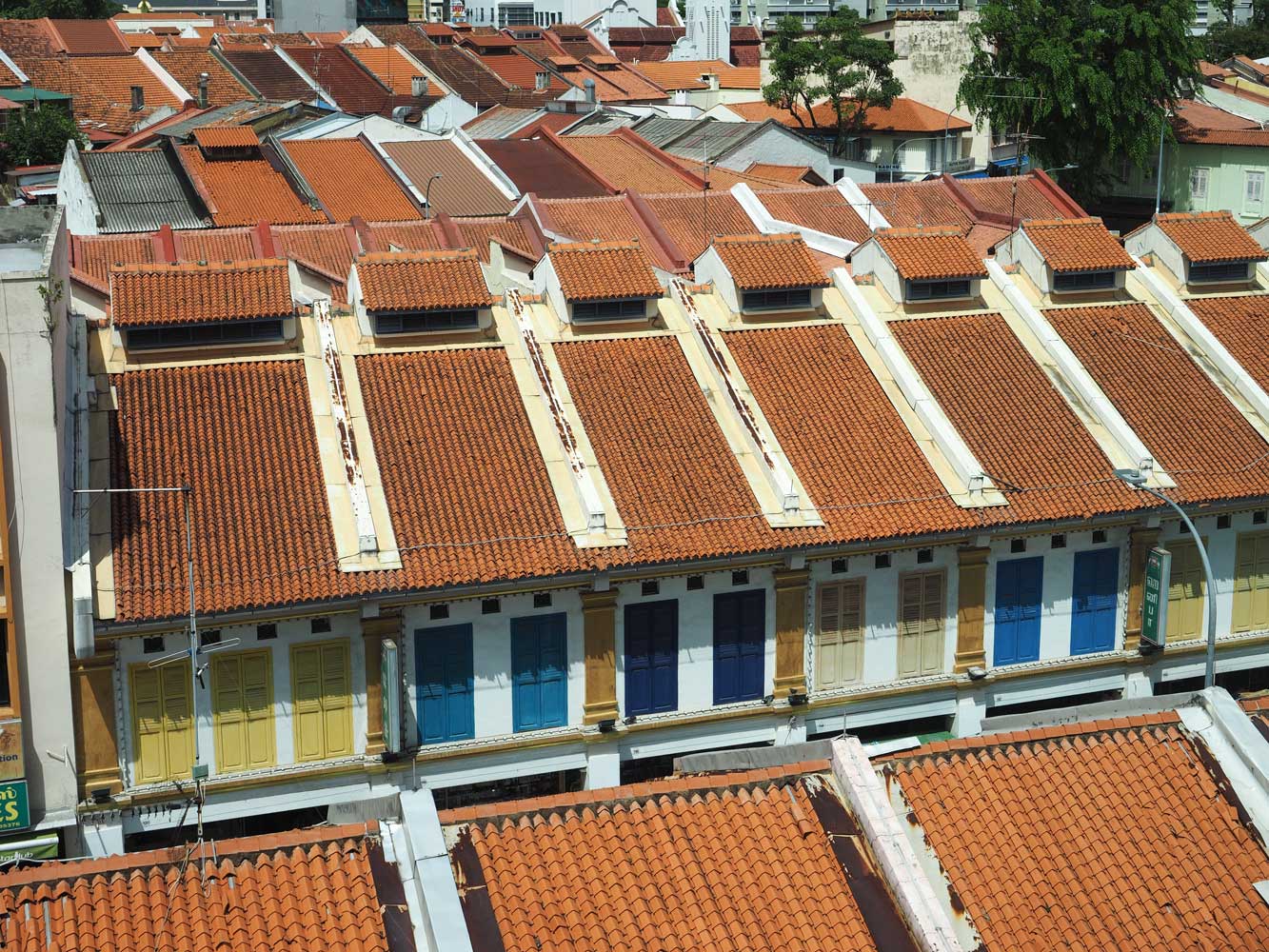
Shop houses of Little India behind the India Cultural Centre
I strolled northeast on Serangoon Road, the main thoroughfare through Little India, passing several Tamil Hindu temples, a mosque, a couple Buddhist temples, and many attractive old shophouses. As the sun went down I stepped into MTR 1924 (438 Serangoon Rd.), another popular vegetarian Indian restaurant chain, for a light dinner of tomato uttapam with a masala tea. At a nearby MTR subway station I topped up my EZ-Link transit card another S$10, then caught a train and a bus back to my Airbnb.
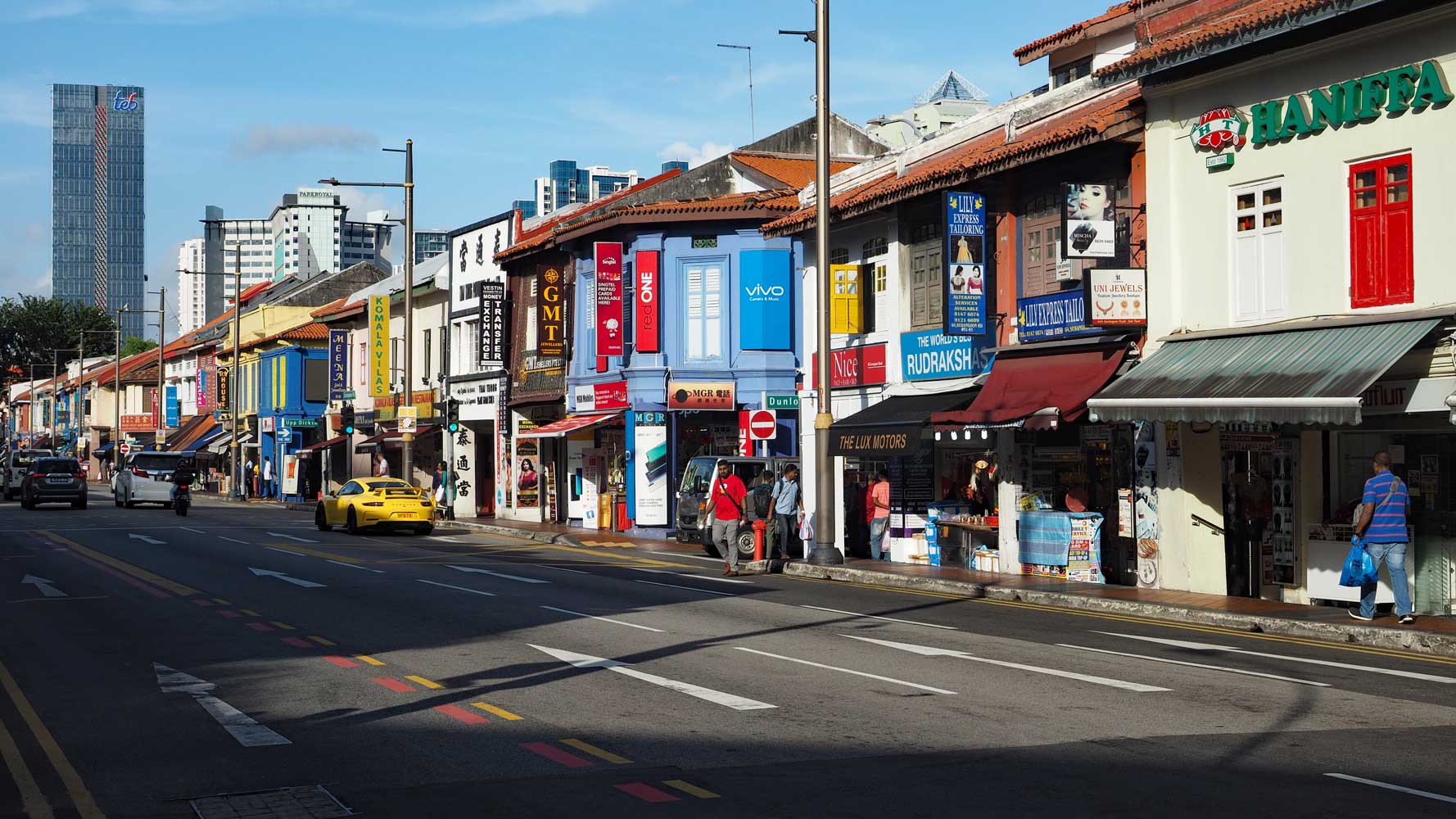
Indian shops and restaurants line Buffalo Road, just off Serangoon Road
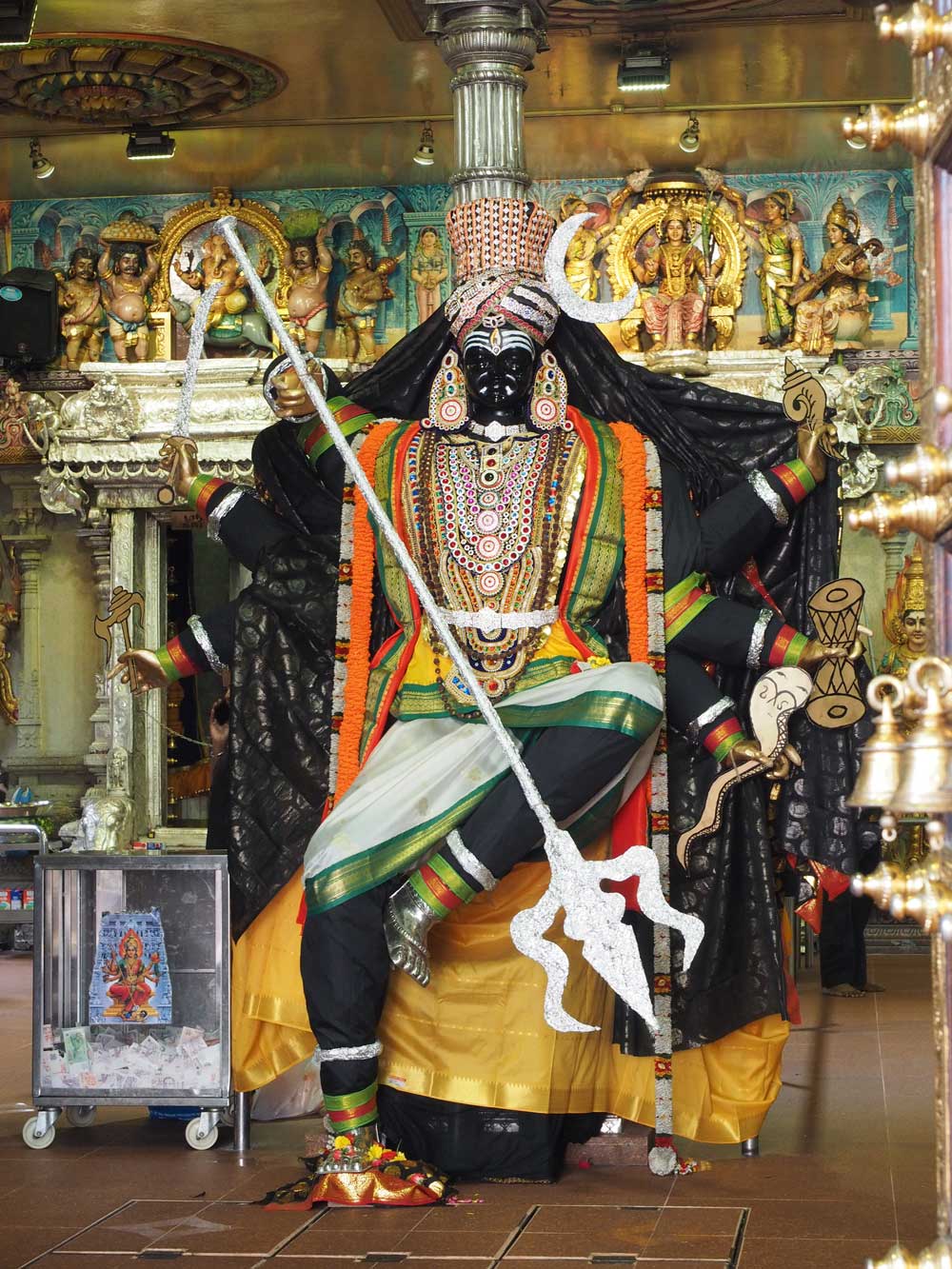
Sri Veeramakaliamman Temple, dedicated to Kali, a fierce incarnation of
Shiva’s wife and ‘destroyer of evil.’
A shrine to the goddess existed on the
site as early as 1855.

Time-worn shops on Serangoon Road
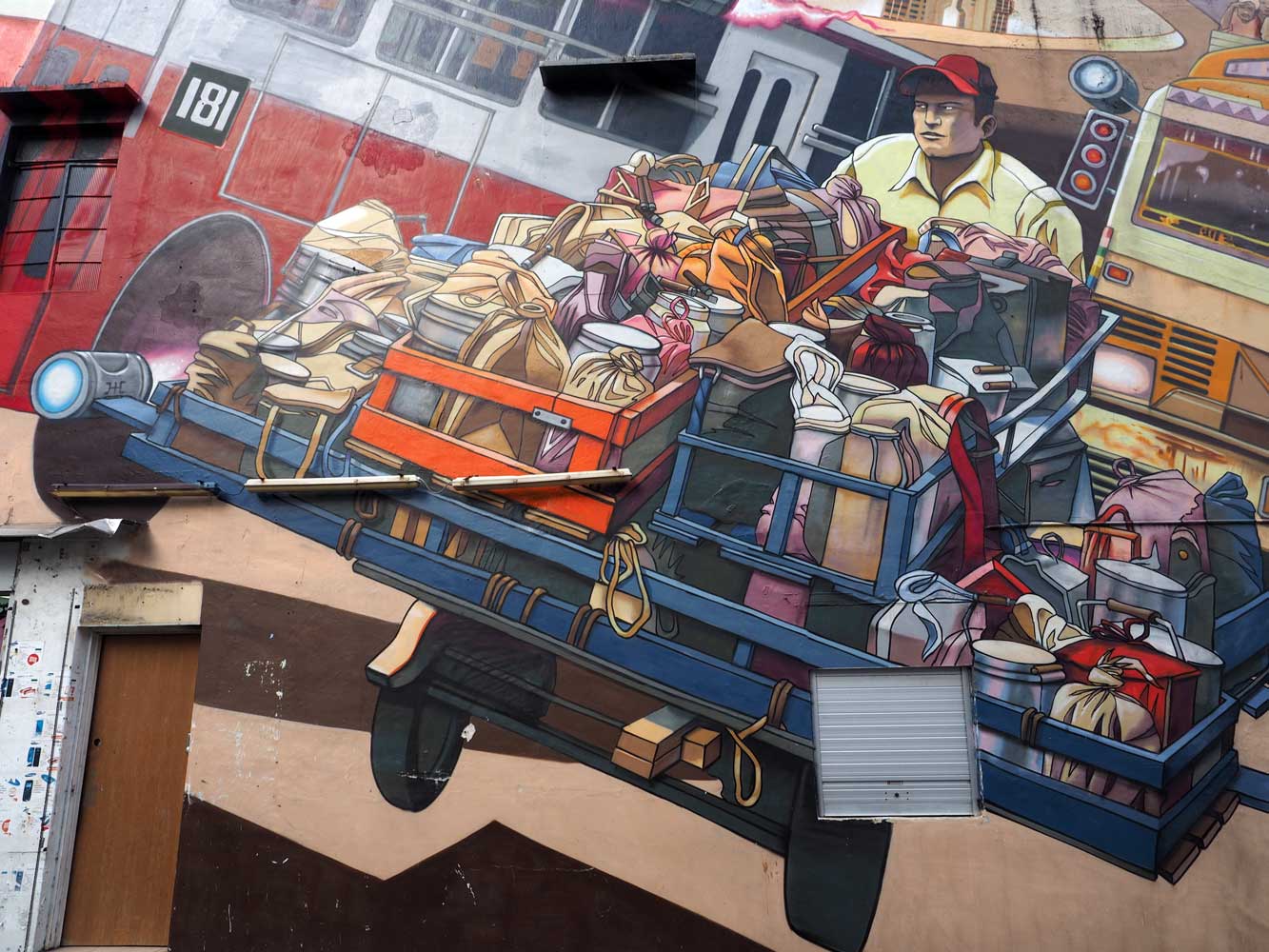
Mural on side street just off Serangoon Road
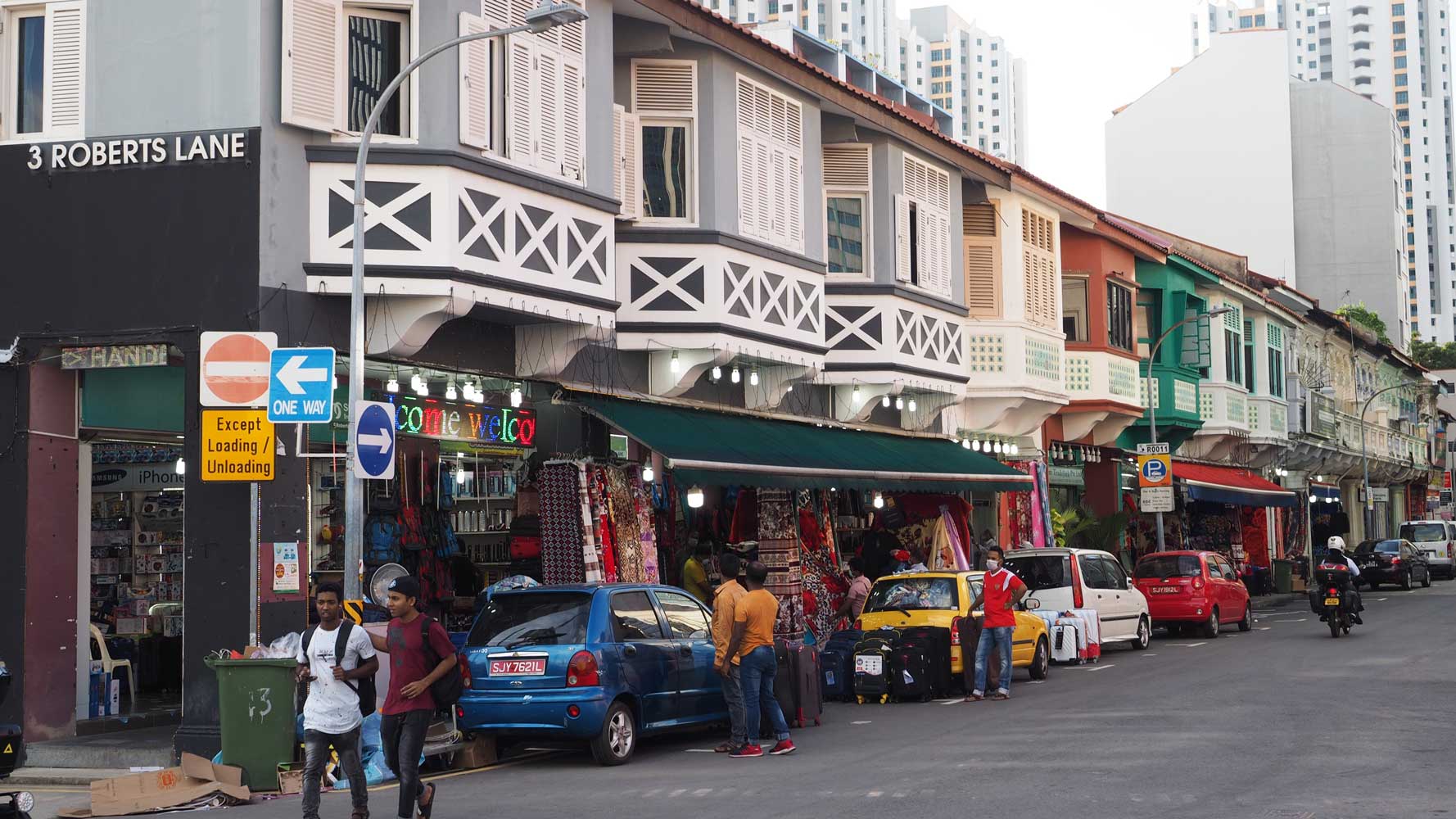
Shophouses at corner of Serangoon Road and Roberts Lane
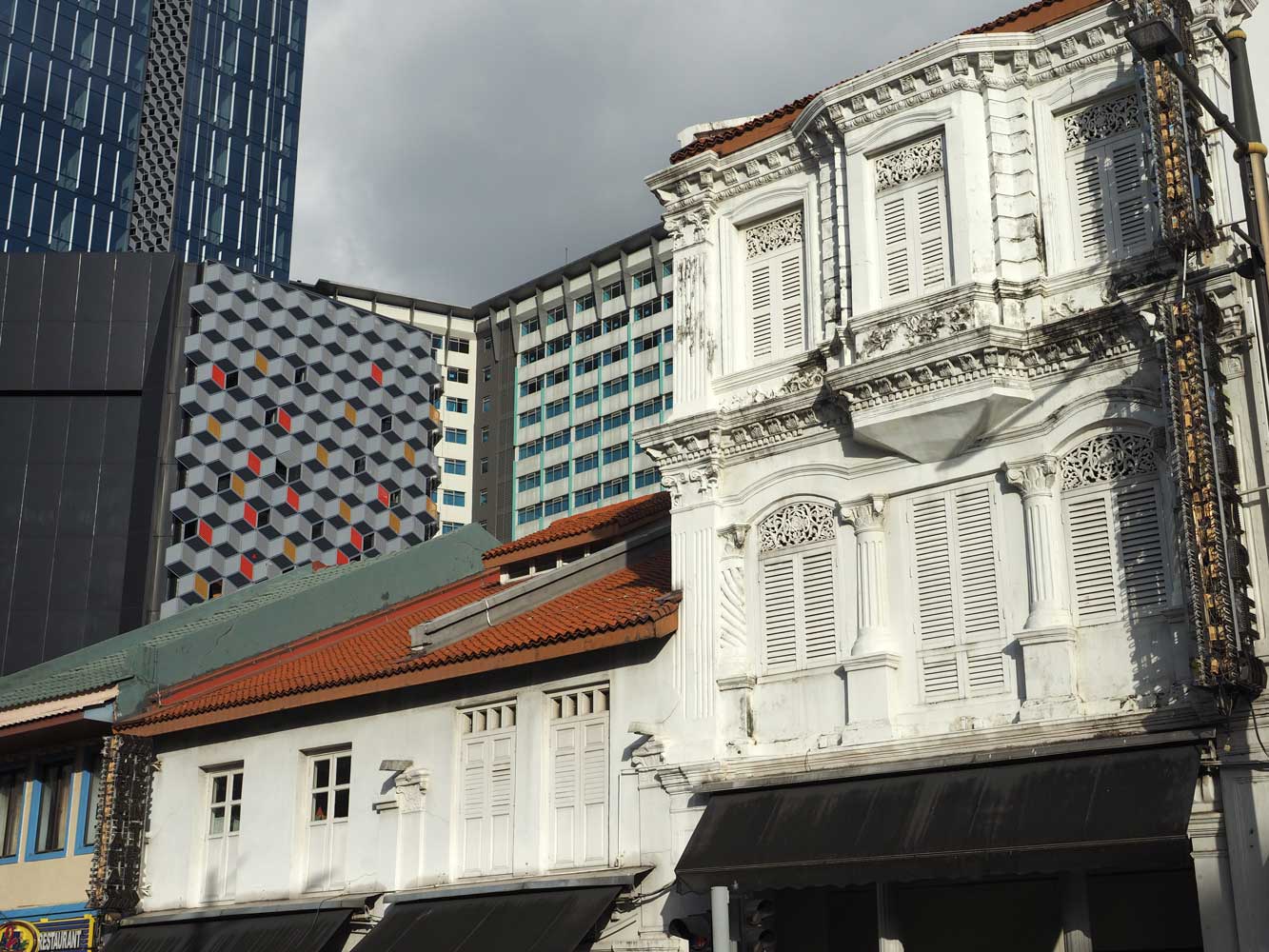
New meets old in Little India

Two shops trying to outdo each other on Race Course Road
21 February Singapore
I headed by bus straight for National Gallery Singapore
https://www.nationalgallery.sg/ that houses the world’s largest public collection
of Singapore and Southeast Asian modern art. Entry for general admission and the
Singapore Biennale costs a stiff S$30, but I paid S$18.75 with the senior and Singapore
Airlines discounts. Two grand heritage buildings—the former city hall and supreme
court—provide a superb home for the collection and special shows. A lofty glassed-in
atrium connects the two structures and is ideal for large installations, currently
a hanging artwork of wooden squares and mirrors suspended by a complex system of
threads. I started in the basement with the temporary show ‘Suddenly Turning Visible:
Art and Architecture in Southeast Asia (1969–1989)’ about how artists in Manila,
Bangkok, and Singapore responded to that period of rapidly changing society. I then
moved upward through the galleries and felt impressed by the variety and quality
of the works. Some artists had come to Singapore from China and adapted traditional
ink and scroll styles. Other artists had spent time in Europe and incorporated those
influences. And some strived for unique Southeast Asian compositions. Paintings
predominated, though I saw both conventional and genuinely wacky sculptures. The
museum hosted many works of the Singapore Biennale 2019 in three large galleries
and other spaces, but I found the poor-quality video presentations and nutty installations
to be mostly disappointing. Friday has the advantage of staying open until 9 p.m.,
and I made the most of it, wandering the halls for nearly eight hours! Even so,
much remained to be seen, and I hope to return. Outside I walked past
the great field of Padang, known for its historic events and sporting grounds, to
the Singapore River and enjoyed nighttime views of the city. A bus and subway brought
me to Komala Vilas Vegetarian Restaurant in Little India for a tasty South Indian
thali.

National Gallery Singapore has much wonderful art in the former city hall
(near) and supreme court (with dome).
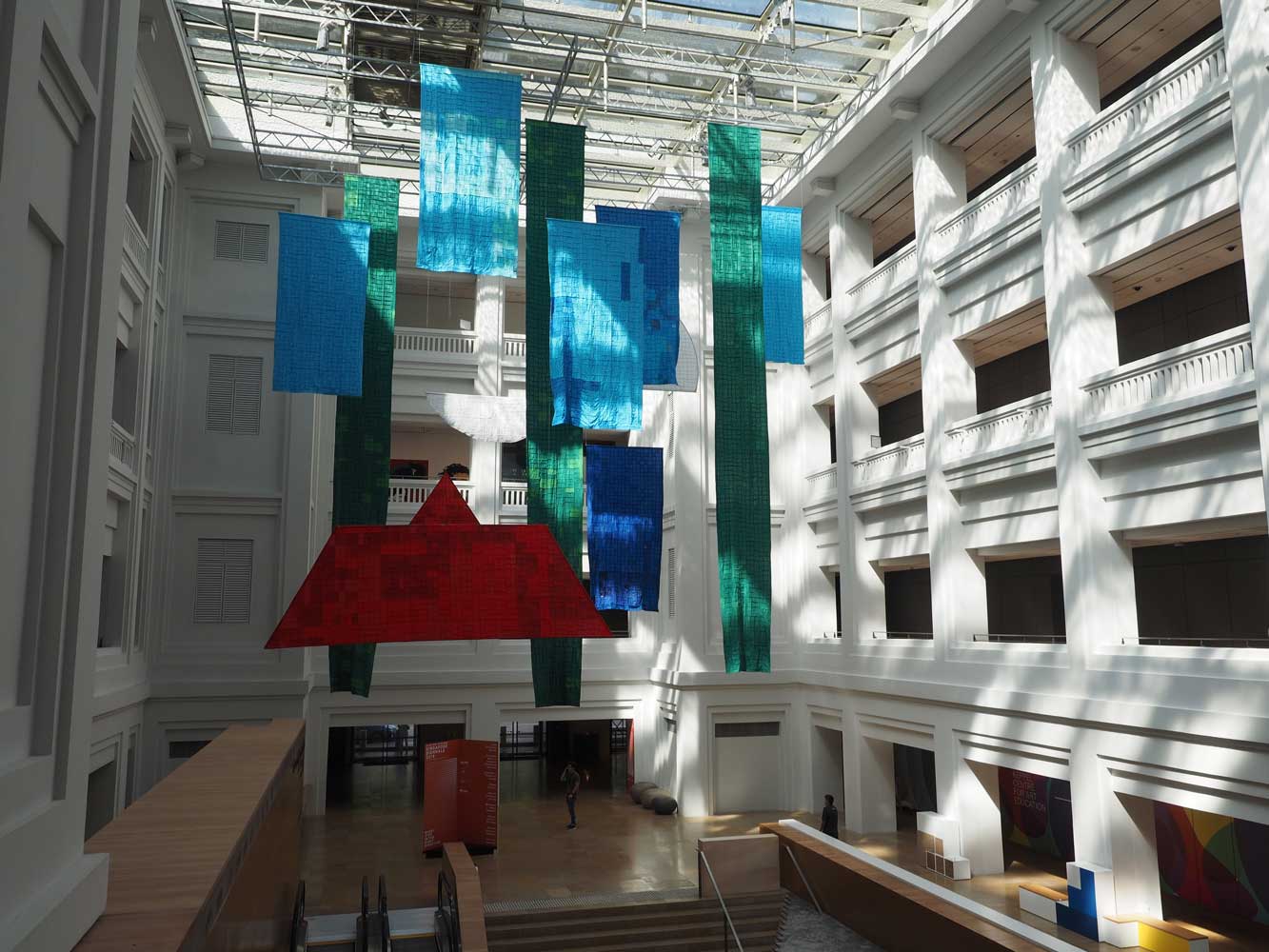
In the Skin of a Tiger: Monument to What We Want (Tugu Kita) (2019) by
Malaysian artist Sharon Chin
This Singapore Biennale 2019 commission hangs in the atrium in the former city
hall.
The colors of the flags were quilted together from discarded political
banners of the recent Malaysian general election.
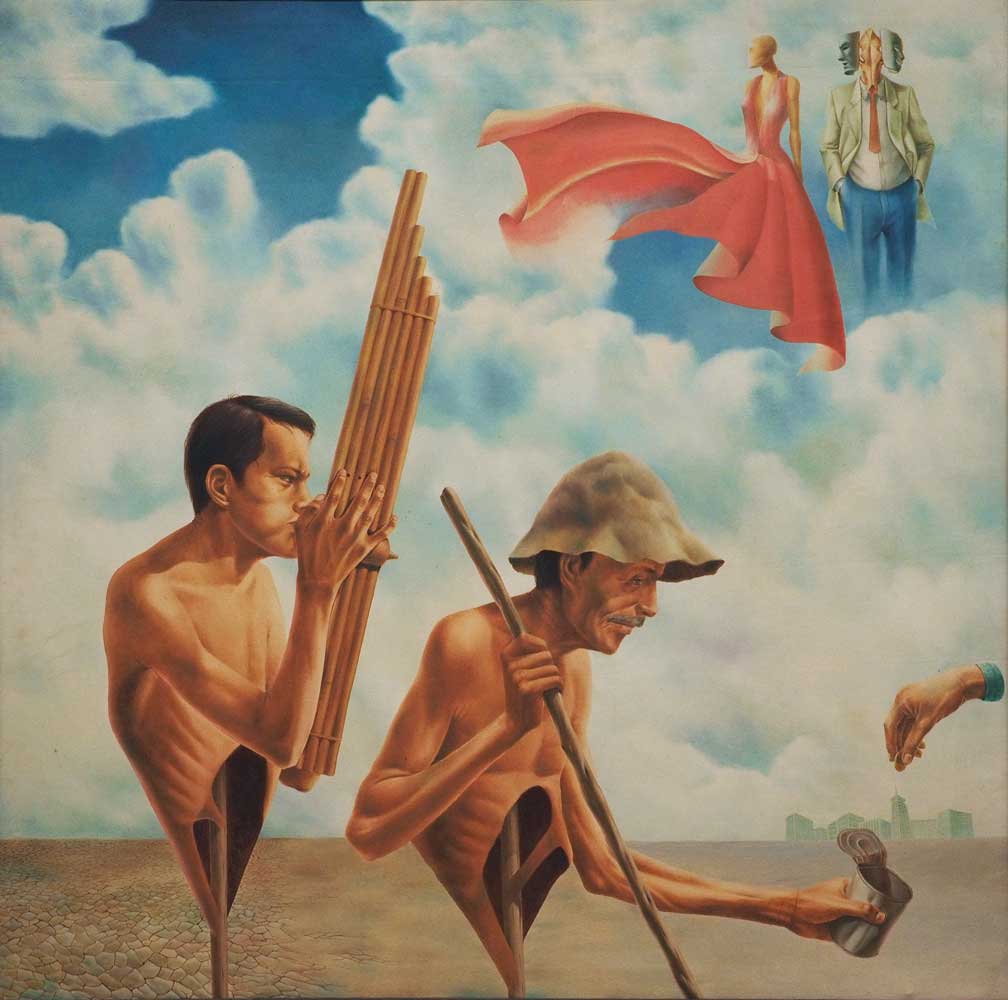
Music, Lives, and Farmers (1985) by Thai artist Paisal Theerapongvisanuporn,
who made this work as part of the Vane Group, a group of artists who wanted to
highlight the social distress caused by capitalism and political upheaval. Now
in the exhibition, ‘Suddenly Turning Visible: Art and Architecture in Southeast
Asia (1969–1989).’

Stardust: Soaring Through the Sky’s Embrace (2019; mixed media) by Filipino
artist Mark Justiniani.
This is one of a series of lightboxes using mirrors and
other reflective objects to create surreal worlds.
And for even greater effect,
you can walk atop the artworks!

Money Suit (1982; paper collage and cotton) by Singapore artist Vincent Leow, who wore this
in a performance to critique materialism and consumerism in Singapore.
The
artist stuffed his mouth with fake American dollar bills and leapt around as a
mythical three-legged toad, a symbol of wealth in Chinese geomancy.
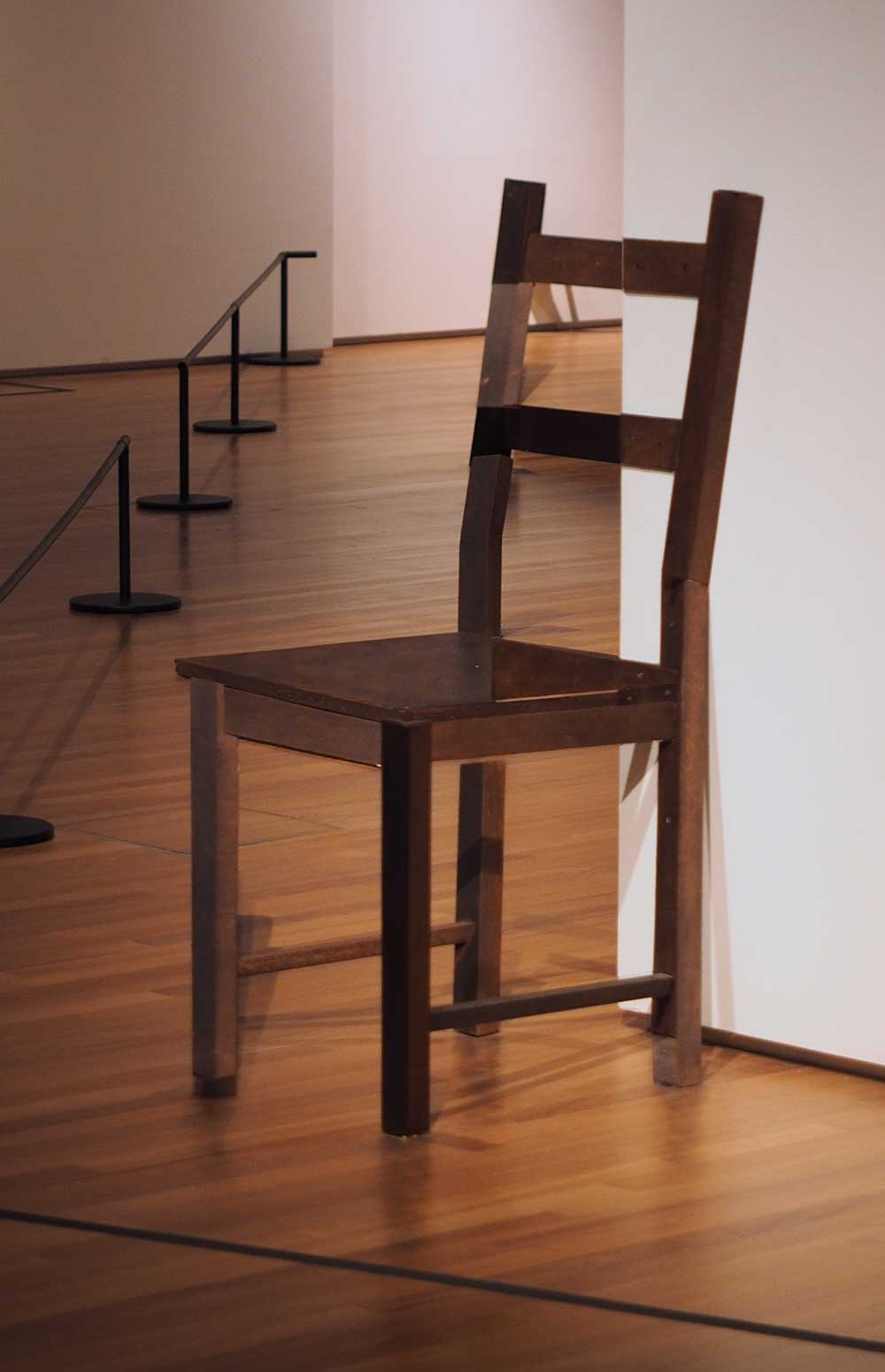
Chair (1997, remade for display in 2015) by Singapore artist Matthew Ngui.
Is it really a chair? That depends on one’s point of view!
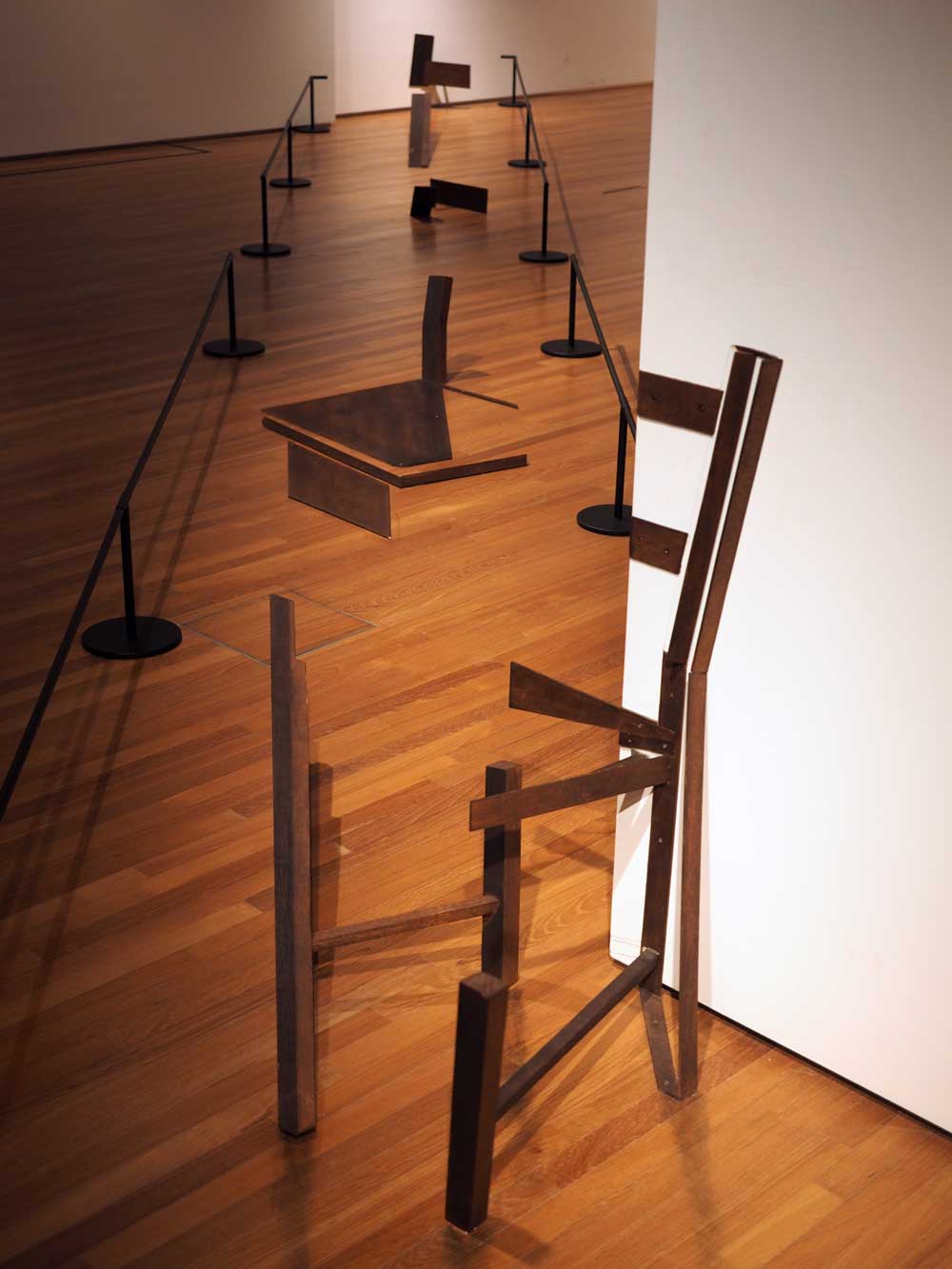
The same artwork from a different angle
It’s bizzare to watch someone
walk through the installation when it seems to be a chair!

Singapore River (Elgin Bridge) (1979; Chinese ink and color on paper) by
Singapore artist Lim Tze Peng

Singapore Waterfront (1963) by Georgette Chen (b. 1906 China; d. 1993
Singapore), who had an itinerant early
life moving between cosmopolitan cities of Europe, America, and Asia before
permanently settling in Singapore in 1953.
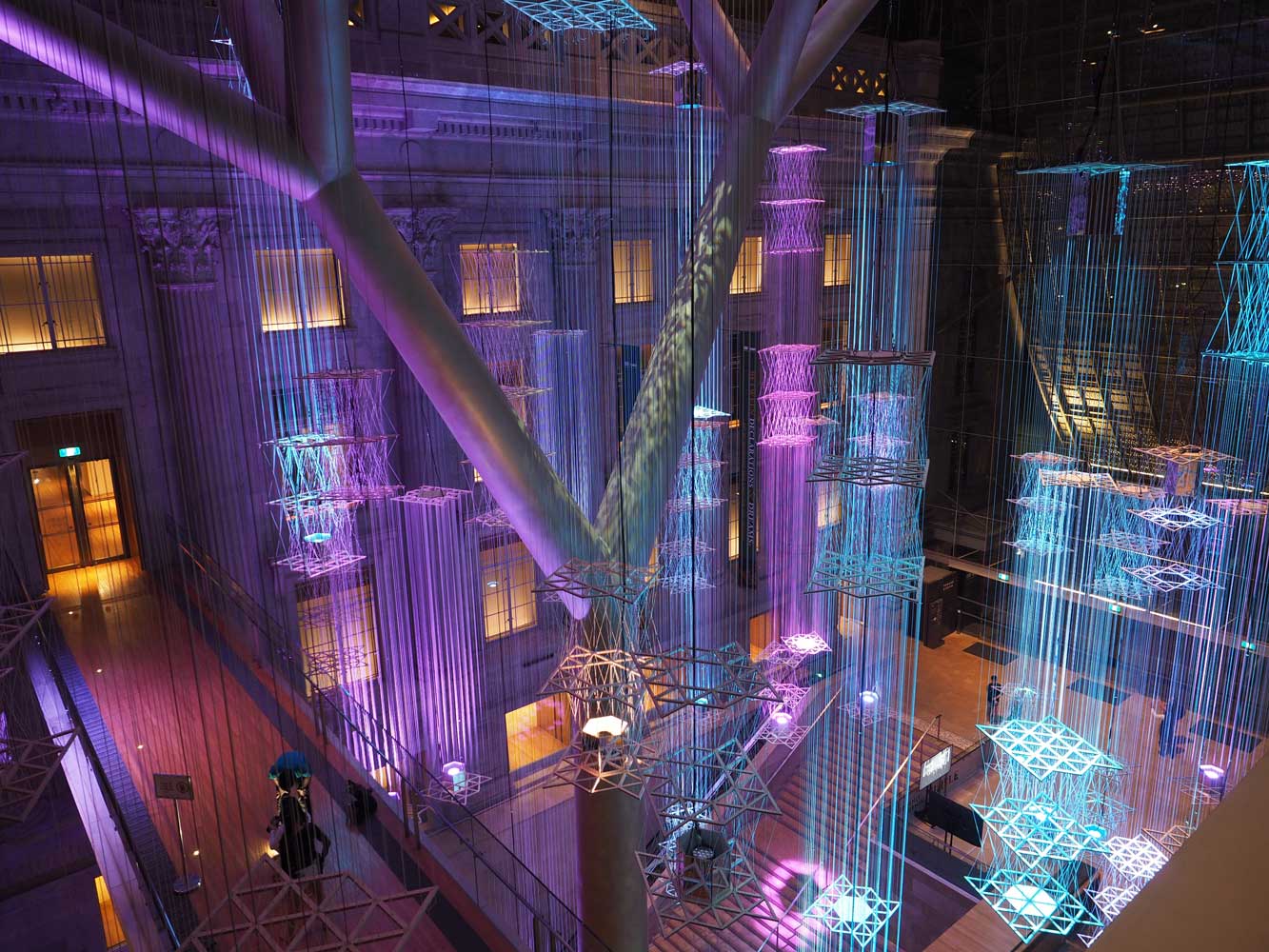
Floating City by Nipek x KNOTS—a hanging in the Padang Atrium between the
former city hall and supreme court—resembles skyscrapers.
It looks best when illuminated
by colored lights, a special treat for Friday-night visitors.
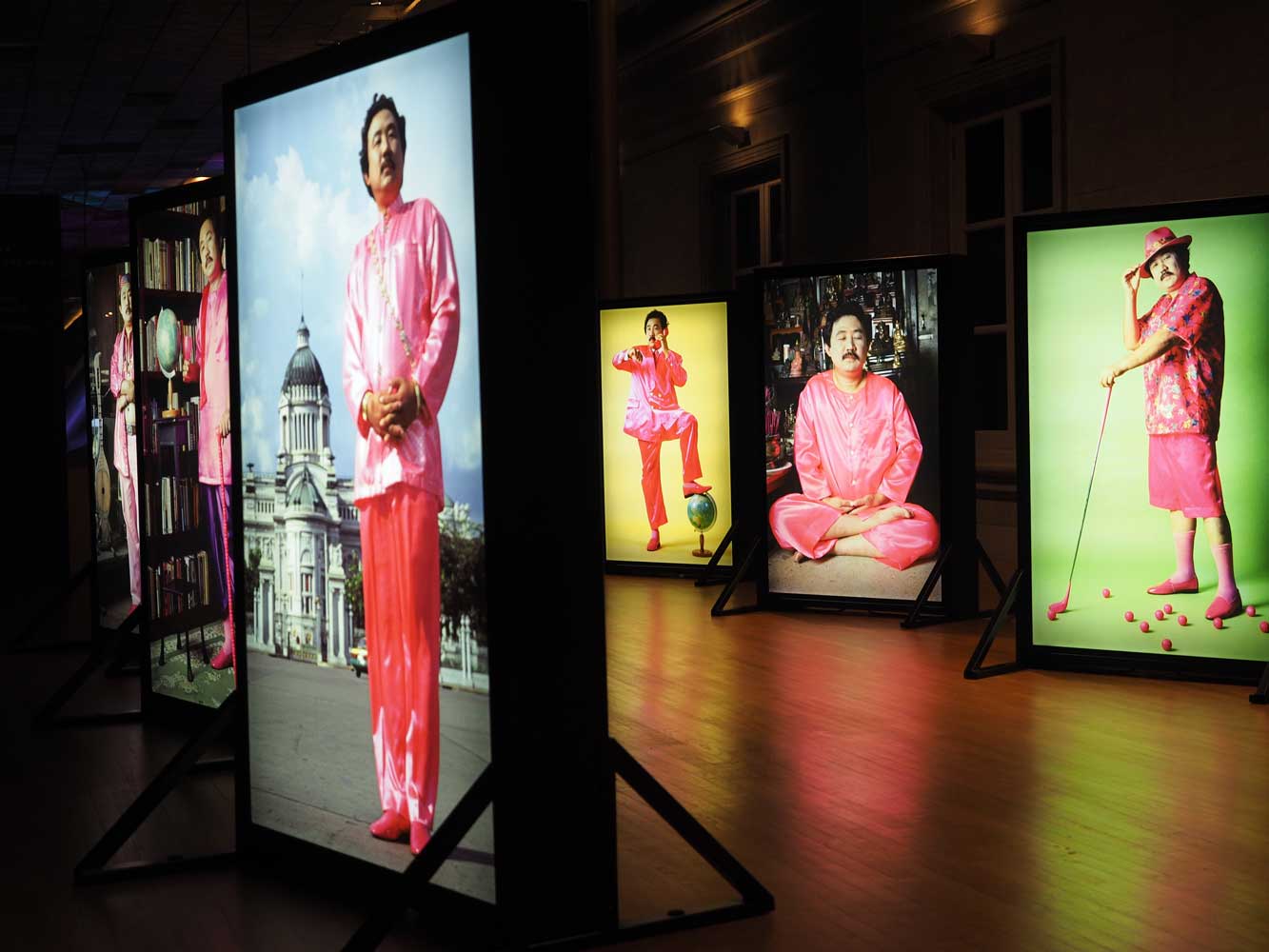
Shocking Pink Collection (1998; Duratrans prints in light boxes) by Thai
artist Manit Sriwanichpoom, who declared, “Like most tourists today, Pink Man
travels not to learn but to consume; to collect exotic destinations, to shop, to
show off. He searches but he never learns because he is insincere.” Pink Man is
a subversive and humorous criticism of the consumerism that swept through
Bangkok during the 1997 Asian financial crisis.

Nighttime reflections in the Singapore River
22 February Singapore
On a typically partly cloudy tropical
day, I caught a bus to Merlion Park on the waterfront where the Singapore River
meets Marina Bay. A legend from the 14th century tells of a Sumatran prince who
thought he caught a glimpse of a lion here and named the place ‘Lion City.’ The
site also had the Javanese name ‘Temasek’ (sea town) so an 8.6-meter-tall water-spouting
statue of the Merlion combines both heritages with the head of lion and a body of
a fish. Surrounded by sweeping views across the water on one side and some of Singapore’s
highest skyscrapers on the other, it’s now a top selfie photo spot!

The Merlion, Singapore’s mascot
Trails on this side of the bay make a pleasant walk, and I followed the shore south, then around to the three-towered Marina Bay Sands complex on the other side. Lots of unusual architecture overlooks the water, such as the flower-shaped ArtScience Museum, which I thought looked ugly from a distance yet pretty when underneath. For the big picture of Singapore, I went up to the 57th-floor observation Sands SkyPark Observation Deck https://www.marinabaysands.com/attractions/sands-skypark.html atop the Marina Bay Sands for S$20 (The adult price is S$26, but I got a $3 senior discount and another S$3 off because I had a Singapore Airlines ticket.). A 340-meter-long (1,120-ft) curved silver ‘boat’ sits atop the towers with an observation deck at the bow and the remainder a garden and what must be one of the world’s best infinity pools, 150 meters (490 ft) long, but only accessible to hotel guests. From the deck I enjoyed the incredible panorama of Singapore all around, the sea to the east, and a bird’s eye view of Gardens by the Bay directly below. Of course I had to stay and watch the sunset, then experience night coming over Singapore! I snagged a spot to watch the Sound-and-Light Show in the Supertree Grove, impressive from this height, though the music could barely be heard. I had hoped to see the music fountain show at Marina Bay Sands, but it had been canceled due to concerns with the coronavirus (COVID-19). Getting back to ground level took awhile as most of the crowd on the deck had the same idea. I then got on the MRT subway for a ride to Little India and a South Indian thali at Komala Vilas Vegetarian Restaurant.
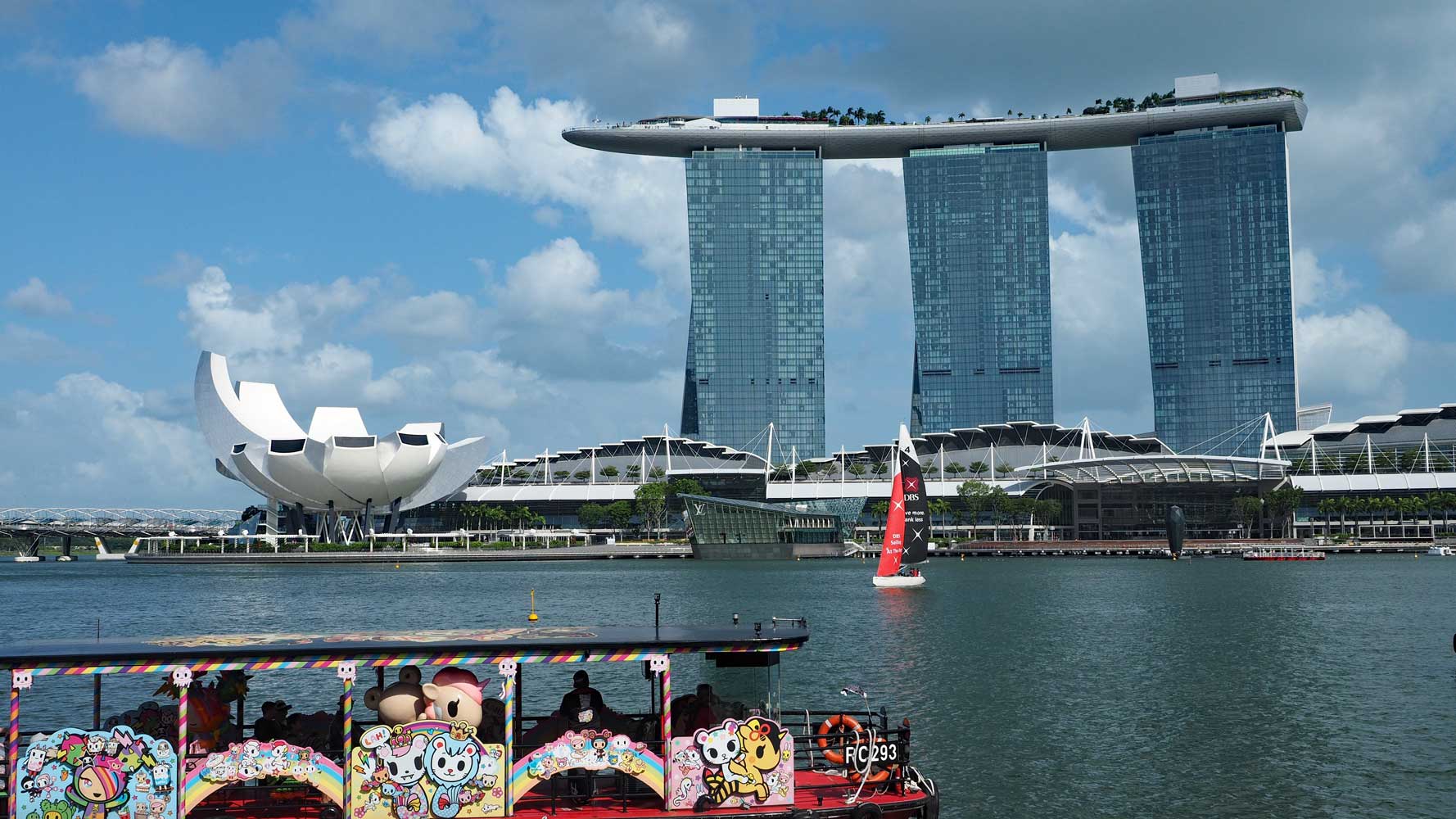
The white ArtScience Museum (left) is part of the Marina Bay Sands complex.
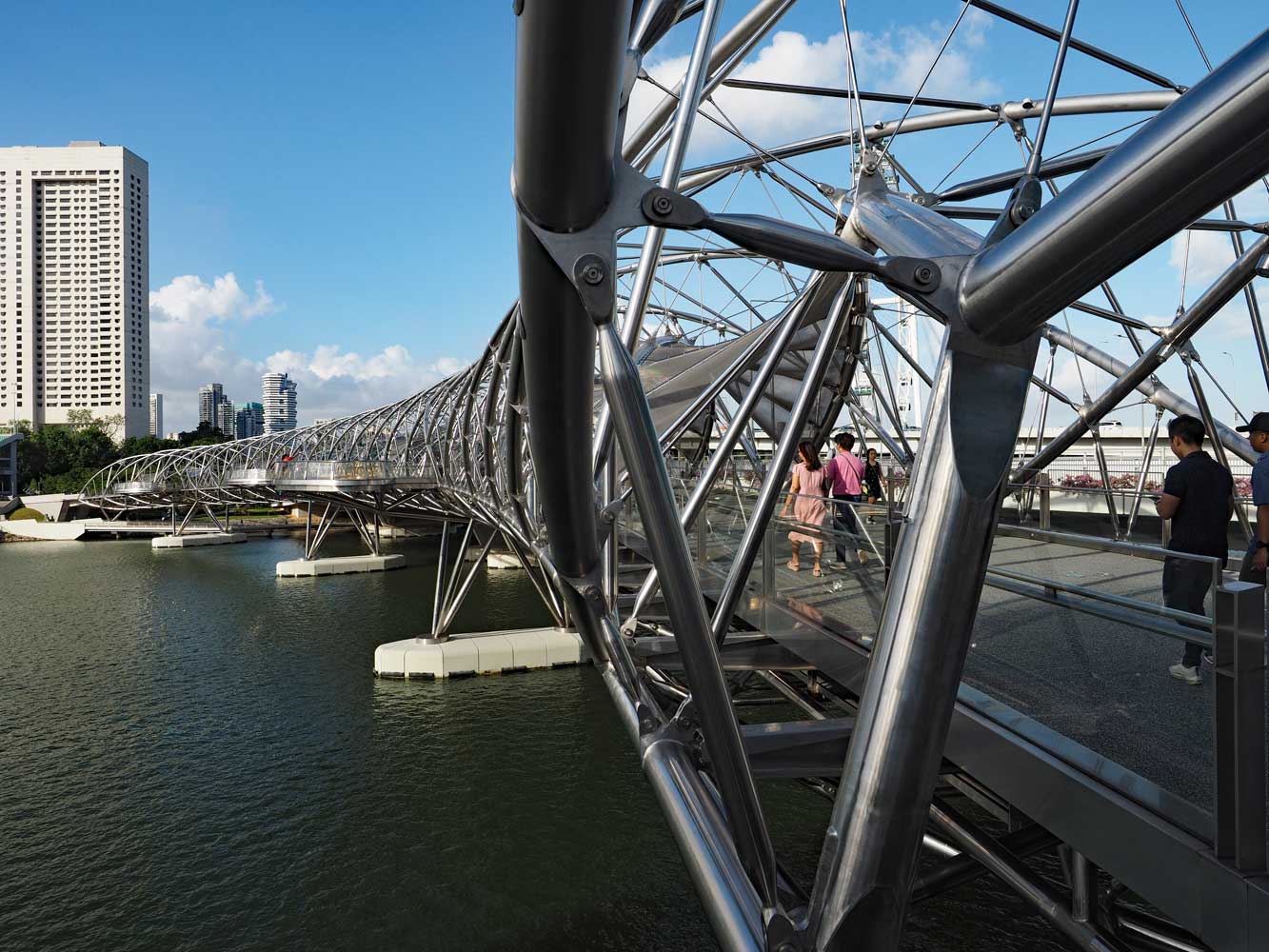
Helix Bridge, which spans the mouth of Marina Bay, has an amazingly complex
design!
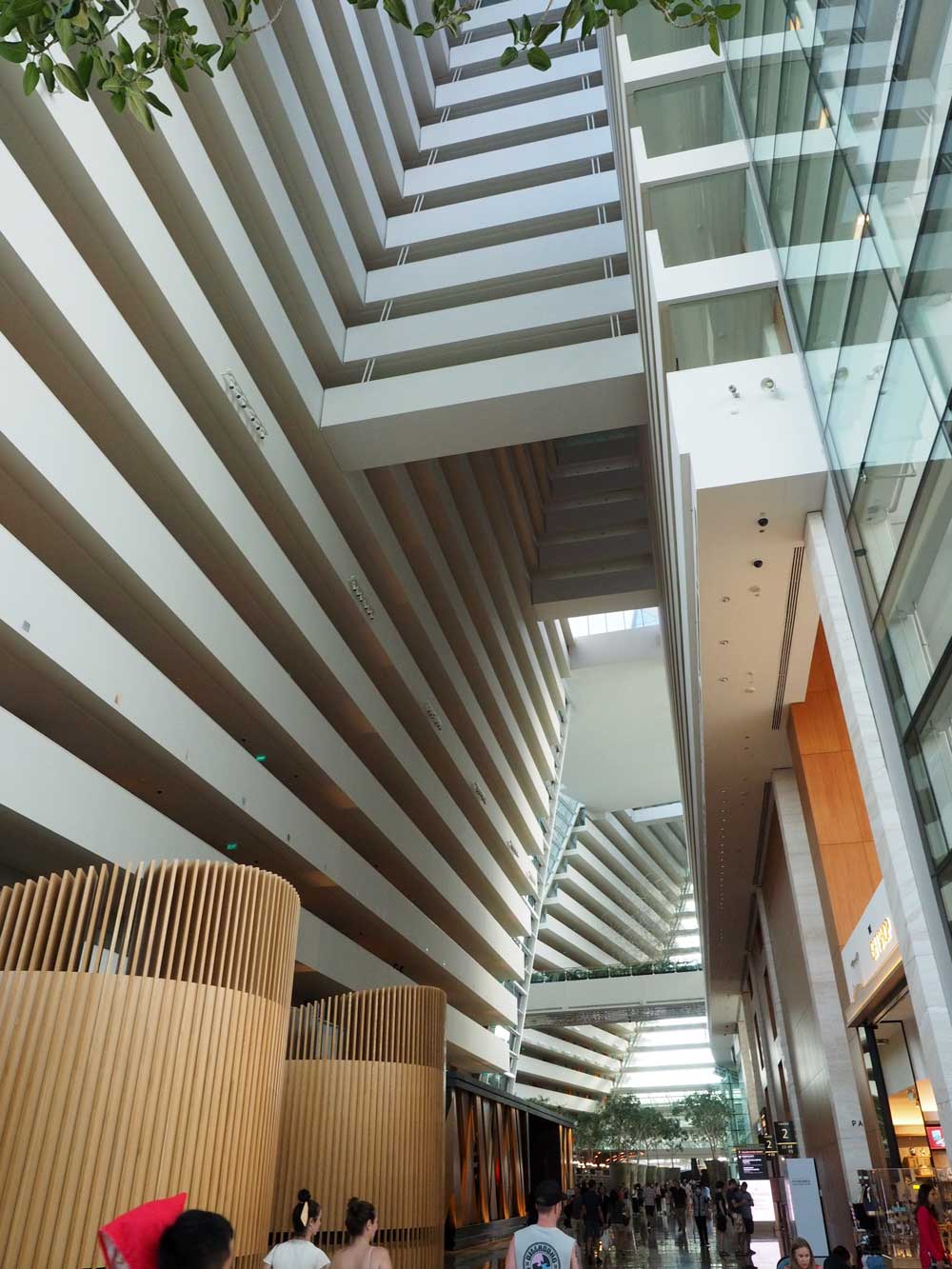
The lobby of Marina Bay Sands Hotel really soars!
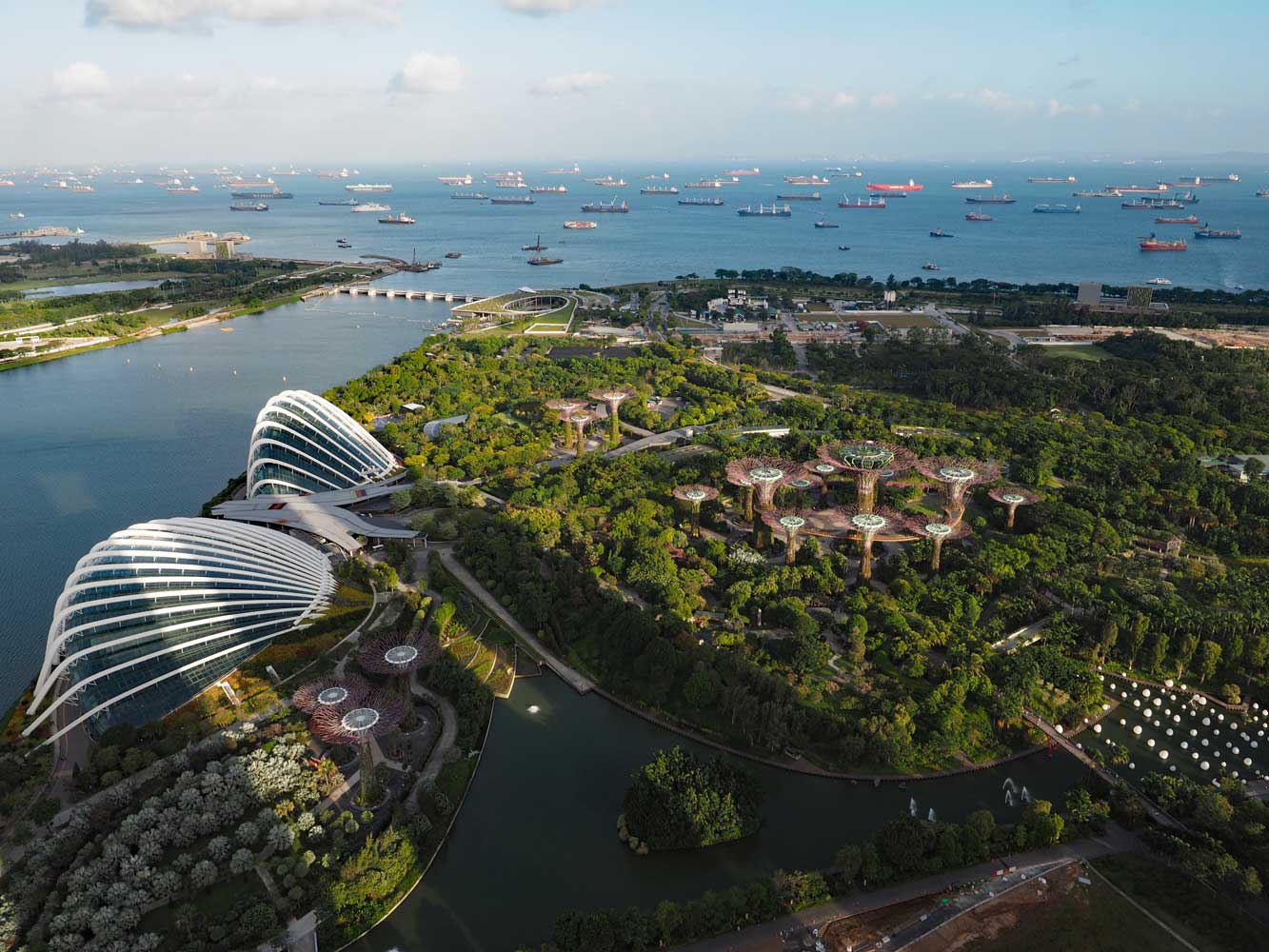
Late afternoon sun casts a shadow of Marina Bay Sands towers across Gardens by the
Bay.

Birds-eye view of the Supertree Grove
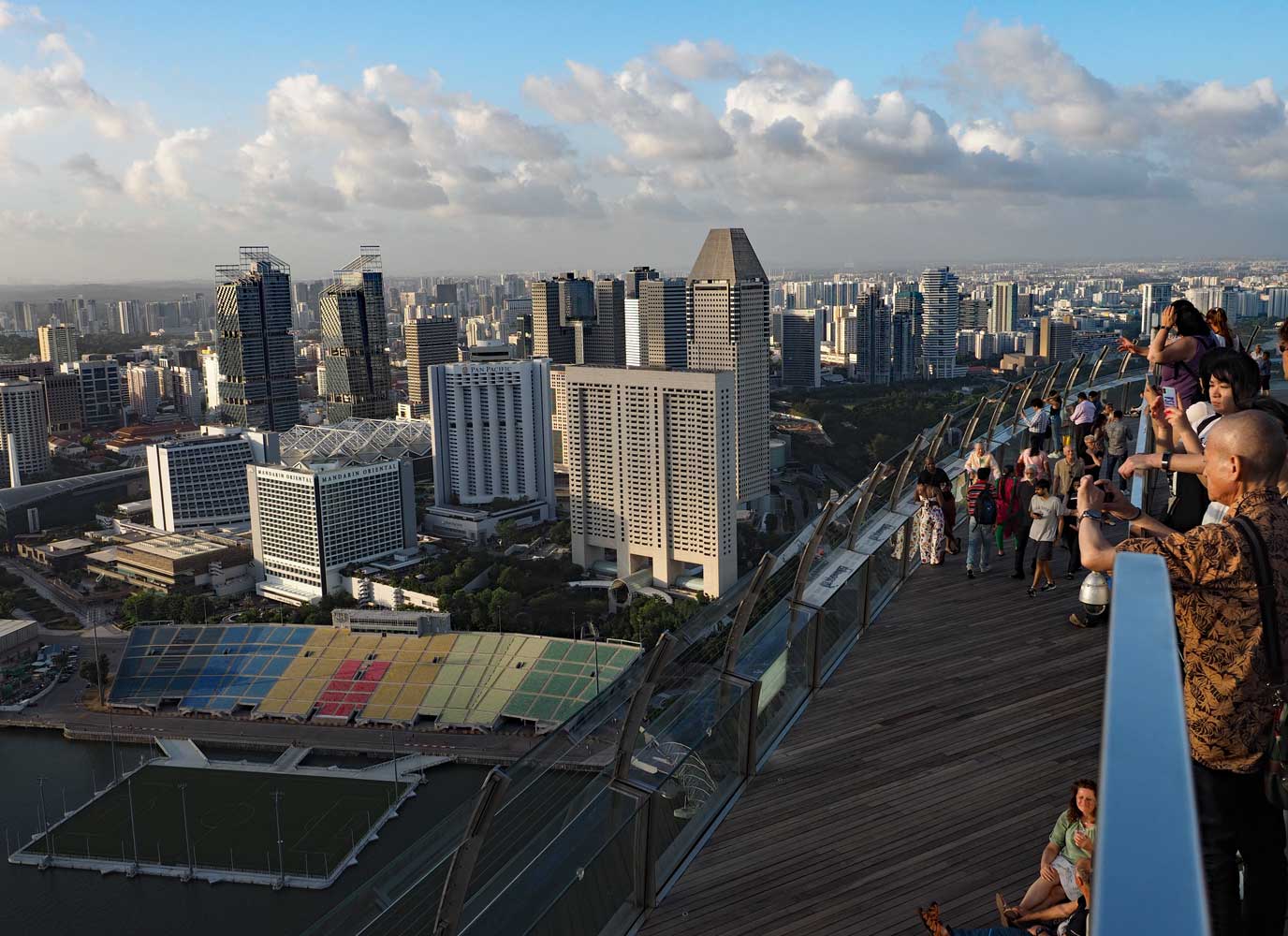
High-rise buildings stretch to the horizon from this perch.
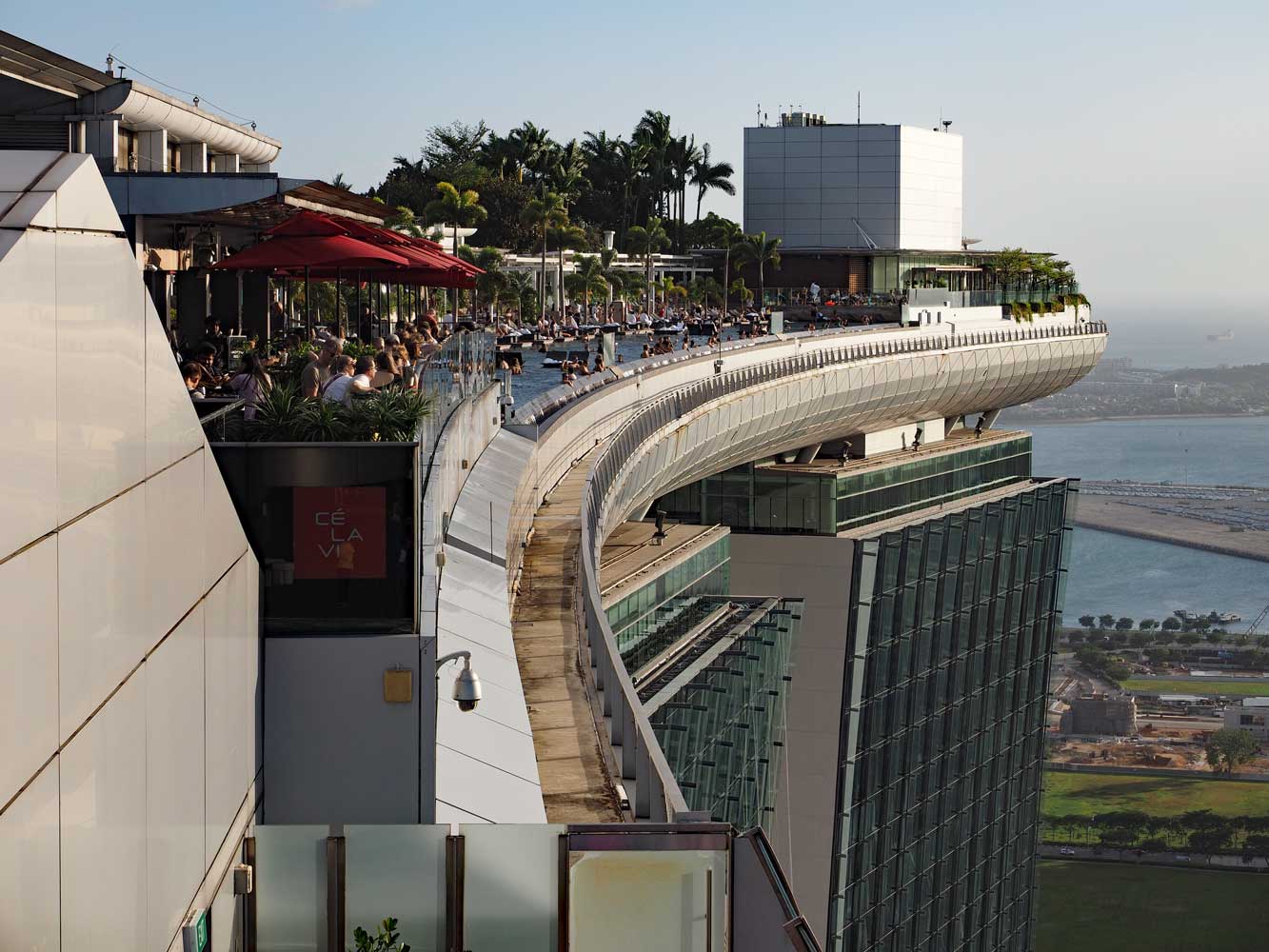
The infinity pool atop Marina Bay Sands has an unbeatable view!

Singapore sunset

Lights come on at Gardens by the Bay.
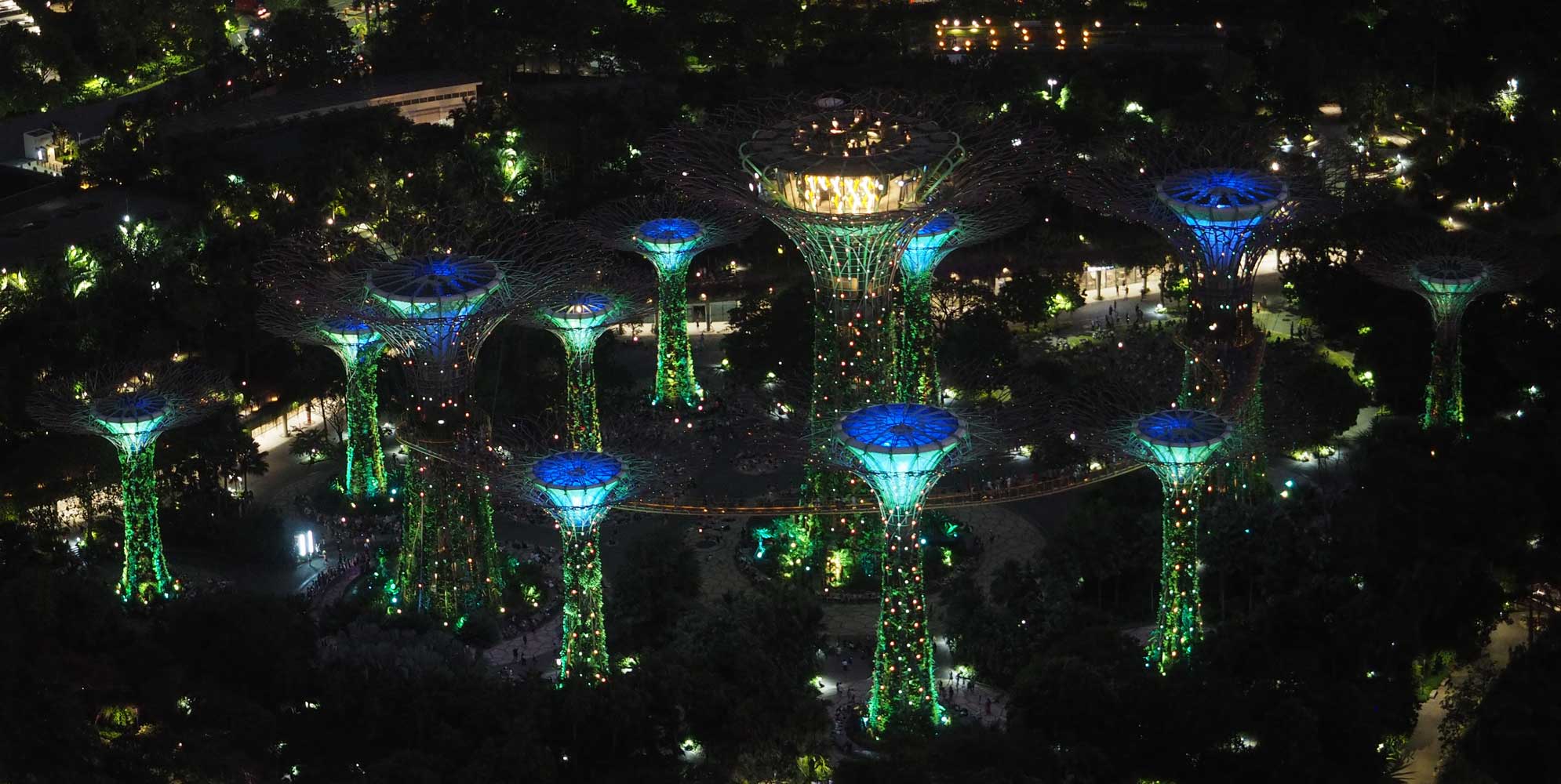
The Sound-and-Light Show in the Supertree Grove also dazzles from above.
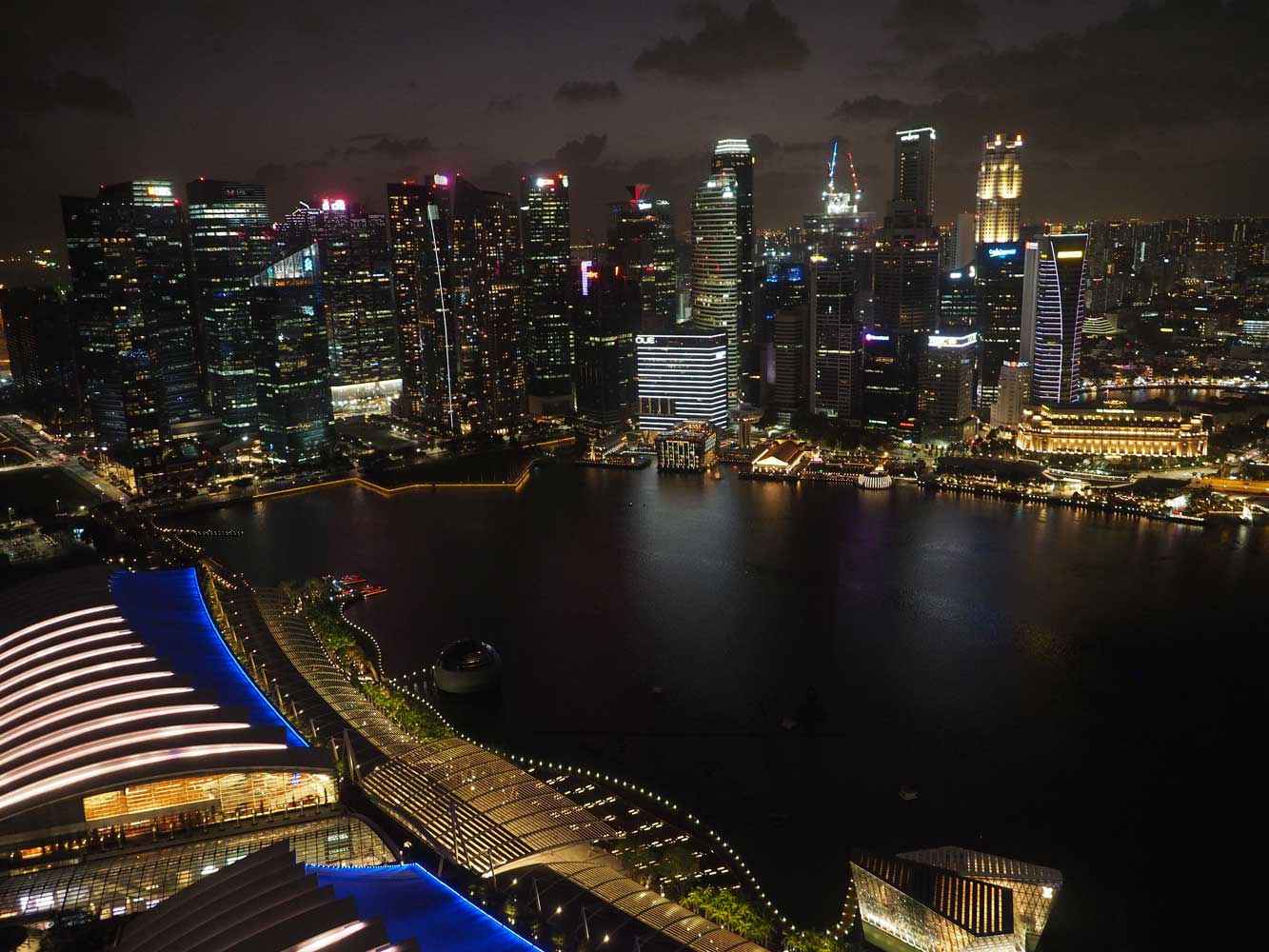
Marina Bay sparkles at night!
On to Singapore—Part 3: Battlebox, Art, and
Chinatown
Back to beginning of “Backpacking
2020: India, Singapore, and Philippines”